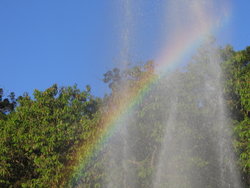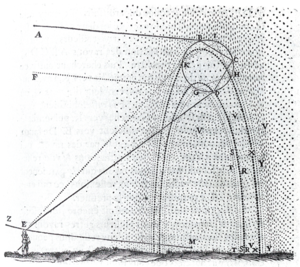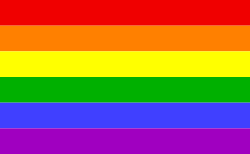Rainbow
2007 Schools Wikipedia Selection. Related subjects: Climate and the Weather

A rainbow is an optical and meteorological phenomenon that causes a nearly continuous spectrum of light to appear in the sky when the Sun shines onto droplets of moisture in the Earth's atmosphere. It takes the form of a multicoloured arc, with red on the outside and violet on the inside. A double rainbow includes a second, fainter, arc with colors in the opposite order.
Even though a rainbow spans a continuous spectrum of colours, traditionally the full sequence of colours is most commonly cited as red, orange, yellow, green, blue, indigo and violet. It is commonly thought that indigo was included due to the different religious connotations of the numbers six and seven at the time of Isaac Newton's work on light, despite its lack of scientific significance and the poor ability of humans to distinguish colours in the blue portion of the visual spectrum.
Scientific explanation
The rainbow effect can be observed whenever there are water drops in the air and sunlight shining from behind the observer at a low altitude or angle. The most spectacular rainbow displays when half of the sky is still dark with draining clouds and the observer is at a spot with clear sky overhead. The rainbow effect is also commonly seen near waterfalls or fountains. Rainbow fringes can sometimes be seen at the edges of backlit clouds and as vertical bands in distant rain or virga. The effect can also be artificially created by dispersing water droplets into the air during a sunny day.
In a very few cases, a moonbow, or night-time rainbow, can be seen on strongly moonlit nights. As human visual perception for colour in low light is poor, moonbows are most often perceived to be white.
The rainbow's appearance is caused by dispersion of sunlight as it is refracted by (approximately spherical) raindrops. The light is first refracted as it enters the surface of the raindrop, reflected off the back of the drop, and again refracted as it leaves the drop. The overall effect is that the incoming light is reflected back over a wide range of angles, with the most intense light at an angle of about 40°–42°. This angle is independent of the size of the drop, but does depend on its refractive index. As seawater has a higher refractive index than rain water, the radius of a 'rain'bow in a sea spray is smaller than a true rainbow. This is visible to the naked eye by a misalignment of these bows .
Since the water is dispersive, the amount that the sunlight is bent depends upon the wavelength, and hence colour, of the light's constituent parts. Blue light is refracted at a greater angle than red light, but because the area of the back of the droplet has a focal point inside the droplet, the spectrum crosses itself, and therefore the red light appears higher in the sky, and forms the outer colour of the rainbow. Contrary to popular belief, the light at the back of the raindrop does not undergo total internal reflection; however, light that emerges from the back of the raindrop does not create a rainbow between the observer and the Sun. The spectra emitted from the back of the raindrop do not have a maximum of intensity, as the other visible rainbows do, and thus the colours blend together and do not form a rainbow.
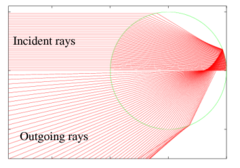
Light rays enter a raindrop from one direction (typically a straight line from the Sun), reflect off the back of the raindrop, and fan out as they leave the raindrop. The light leaving the rainbow is spread over a wide angle, with a maximum intensity of 40.6°–42°.
|
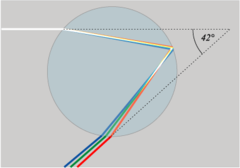
White light separates into different colours ( wavelengths) on entering the raindrop because red light is refracted by a lesser angle than blue light. On leaving the raindrop, the red rays have turned through a smaller angle than the blue rays, producing a rainbow.
|
A rainbow does not actually exist at a location in the sky, but rather is an optical phenomenon whose apparent position depends on the observer's location. All raindrops refract and reflect the sunlight in the same way, but only the light from some raindrops reaches the observer's eye. These raindrops are perceived to constitute the rainbow by that observer. The position of a rainbow in the sky is always in the opposite direction of the Sun with respect to the observer, and the interior is always slightly brighter than the exterior. The bow is centred on the shadow of the observer's head, or more exactly at the antisolar point (which is below the horizon during the daytime), appearing at an angle of approximately 40°–42° to the line between the observer's head and its shadow. As a result, if the Sun is higher than 42°, then the rainbow is below the horizon and cannot be seen as there are usually not enough raindrops between the horizon (that is: eye height) and the ground, to contribute. One exception is when the observer is at the top of a mountain or a similar vantage point, for example an aeroplane (see below). Another exception occurs when the rainbow is produced by a garden sprinkler. In this case to get sufficient drops they must be very small.
It is difficult to photograph the complete arc of a rainbow, which would require an angle of view of 84°. For a 35 mm camera, a lens with a focal length of 19 mm or less would be required, whilst most photographers are only likely to have a 28 mm wide-angle lens. From an aeroplane, one has the opportunity to see the whole circle of the rainbow, with the plane's shadow in the centre. This phenomenon can be confused with the glory, but a glory is usually much smaller, covering only 5°–20°, as opposed to over 80° for a full circle rainbow.
Variations
Occasionally, a second, dimmer secondary rainbow is seen outside the primary bow. Secondary rainbows are caused by a double reflection of sunlight inside the raindrops, and appear at an angle of 50°–53°. As a result of the second reflection, the colours of a secondary rainbow are inverted compared to the primary bow, with blue on the outside and red on the inside. The dark area of unlit sky lying between the primary and secondary bows is called Alexander's band, after Alexander of Aphrodisias who first described it.
|
|
A third, or triple, rainbow can be seen on rare occasions, and a few observers have reported seeing quadruple rainbows in which a dim outermost arc had a rippling and pulsating appearance. These rainbows would appear on the same side of the sky as the Sun, making them hard to spot.
Occasionally, another beautiful and striking rainbow phenomenon can be observed, consisting of several faint rainbows on the inner side of the primary rainbow, and very rarely also outside the secondary rainbow. They are slightly detached and have pastel colour bands that do not fit the usual pattern. They are known as supernumerary rainbows, and it is not possible to explain their existence using classical geometric optics. The alternating faint rainbows are caused by interference between rays of light following slightly different paths with slightly varying lengths within the raindrops. Some rays are in phase, reinforcing each other through constructive interference, creating a bright band; others are out of phase by up to half a wavelength, cancelling each other out through destructive interference, and creating a gap. Given the different angles of refraction for rays of different colours, the patterns of interference are slightly different for rays of different colours, so each bright band is differentiated in colour, creating a miniature rainbow. Supernumerary rainbows are clearest when raindrops are small and of similar size. The very existence of supernumerary rainbows was historically a first indication of the wave nature of light, and the first explanation was provided by Thomas Young in 1804.
Other rainbow variants are produced when sunlight reflects off a body of water. Where sunlight reflects off water before reaching the raindrops, it produces a reflection rainbow. These rainbows share the same endpoints as a normal rainbow but encompass a far greater arc when all of it is visible. Both primary and secondary reflection rainbows can be observed.
A reflected rainbow, by contrast, is produced when light that has first been reflected inside raindrops then reflects off a body of water before reaching the observer. A reflected rainbow is not a mirror image of the primary bow, but is displaced from it to a degree dependent on the Sun's altitude. Both types can be seen in the image to the right.
History of the science of rainbows
The Persian astronomer Qutb al-Din al-Shirazi (1236-1311), or perhaps his student Kamal al-din al-Farisi (1260-1320), is thought to have first given a fairly accurate explanation for the rainbow phenomenon . The work of Robert Grosseteste on light was continued by Roger Bacon, who wrote in his Opus Majus of 1268 about experiments with light shining through crystals and water droplets showing the colours of the rainbow. Theodoric of Freiberg is also known to have given an accurate theoretical explanation of both the primary and secondary rainbows in 1307. He explained the primary rainbow, noting that "when sunlight falls on individual drops of moisture, the rays undergo two refractions (upon ingress and egress) and one reflection (at the back of the drop) before transmission into the eye of the observer" (quoted from David C, Lindberg, Roger Bacon's Theory of the Rainbow: Progress or Regress?, Isis, Vol. 57, no. 2, p. 235). He explained the secondary rainbow through a similar analysis involving two refractions and two reflections.
Descartes, in 1637, further advanced this explanation. Knowing that the size of raindrops didn't appear to affect the observed rainbow, he experimented with passing rays of light through a large glass sphere filled with water. By measuring the angles that the rays emerged, he concluded that the primary bow was caused by a single internal reflection inside the raindrop and that a secondary bow could be caused by two internal reflections. He was able to back this up with a derivation of the law of refraction (subsequently, but independently of, Snell) and correctly calculated the angles for both bows. His explanation of the colours, however, was based on a mechanical version of the traditional theory that colours were produced by a modification of white light.
Isaac Newton was the first to demonstrate that white light was composed of the light of all the colours of the rainbow, which a glass prism could separate into the full spectrum of colours, rejecting the theory that the colours were produced by a modification of white light. He also showed that red light gets refracted less than blue light, which led to the first scientific explanation of the major features of the rainbow. Newton's corpuscular theory of light was unable to explain supernumary rainbows, and a satisfactory explanation was not found until Thomas Young realised that light behaves as a wave under certain conditions, and can interfere with itself.
Young's work was refined in the 1820s by George Biddell Airy, who explained the dependence of the strength of the colours of the rainbow on the size of the water droplets. Modern physical descriptions of the rainbow are based on Mie scattering, work published by Gustav Mie in 1908. Advances in computational methods and optical theory continue to lead to a fuller understanding of rainbows. For example, Nussenzveig provides a modern overview.
Rainbows in culture
Rainbows in religion and mythology
The rainbow has a place in legend due to its beauty and the difficulty in explaining the phenomenon before the work of Descartes in the 17th century (although, as mentioned above, Theodoric of Freiburg had given a satisfactory explanation in the 13th century.)
In Greek mythology, the rainbow was considered to be a path made by a messenger ( Iris) between Earth and Heaven. In Chinese mythology, the rainbow was a slit in the sky sealed by Goddess Nüwa using stones of five different colours. In Hindu mythology, the rainbow is called Indradhanush, meaning the bow of Indra, the God of lightning and thunder. In Norse Mythology, a rainbow called the Bifröst Bridge connects the realms of Ásgard and Midgard, homes of the gods and humans, respectively. The Irish leprechaun's secret hiding place for his crock of gold is usually said to be at the end of the rainbow (which is impossible to reach). In the Hebrew Bible, the rainbow is a symbol of the covenant between God and man, and God's promise to Noah that he would never again flood the entire Earth. The Rainbow has even become the symbol for a modern movement within Judaism called B'nei Noah. B'nei Noah are non-Jews who continue to follow in the ways of their ancestor Noah. The Noahide movement has its roots in Jewish Tradition, specifically the Talmud.
Rainbows in literature
Virginia Woolf in To The Lighthouse highlights the transience of life and Man's mortality through Mrs Ramsey's thought,
"it was all as ephemeral as a rainbow"
An poem of William Wordsworth from 1802, " My Heart Leaps Up When I Behold The Rainbow", begins:
- My heart leaps up when I behold
- A rainbow in the sky:
- So was it when my life began;
- So is it now I am a man;
- So be it when I shall grow old,
- Or let me die!…
However, the Newtonian deconstruction of the rainbow is said to have provoked John Keats to lament in his poem " Lamia" in 1820:
- Do not all charms fly
- At the mere touch of cold philosophy?
- There was an awful rainbow once in heaven:
- We know her woof, her texture; she is given
- In the dull catalogue of common things.
- Philosophy will clip an Angel's wings,
- Conquer all mysteries by rule and line,
- Empty the haunted air, and gnomed mine –
- Unweave a rainbow
- At the mere touch of cold philosophy?
In contrast to this is Richard Dawkins; talking about his book Unweaving the Rainbow: Science, Delusion and the Appetite for Wonder:
- "My title is from Keats, who believed that Newton had destroyed all the poetry of the rainbow by reducing it to the prismatic colours. Keats could hardly have been more wrong, and my aim is to guide all who are tempted by a similar view, towards the opposite conclusion. Science is, or ought to be, the inspiration for great poetry."
The Rainbow is the title of a 1915 novel by British author D.H. Lawrence.
Rainbows in photography
The rainbow is a favourite subject for photographers, to such an extent that photographs of rainbows seem to be more commonplace than rainbows themselves. Occasionally a rainbow photo will be surprisingly artistic and beautiful, as Georges Noblet's "Harpe de Lumière" shown to the right.
Rainbows in popular culture
The rainbow has also been used in more contemporary settings, such as the song " Over the Rainbow" in the musical film The Wizard of Oz, the hit song " The Rainbow Connection" from The Muppet Movie, and in selling Lucky Charms by alluding heavily to leprechaun mythology.
The Greenpeace ship, Rainbow Warrior, was named after a Cree Native American prophecy that stated "When the world is sick and dying, the people will rise up like Warriors of the Rainbow.…"
Rainbow Coalition is a local social action group that was started in Chicago, Illinois by Jesse Jackson from which he launched his national political and social reform platform.
Rainbow Gatherings are gatherings of hippies who come together on public lands with a stated mission to espouse the ideas of peace, love, freedom and community. In the sixties, artists like Peter Blake made use of Rainbow colours in iconic prints such as Babe Rainbow, and later, Bobbie Rainbow.
In recent years, the rainbow flag has become a symbol of the gay and lesbian rights movement and gay pride, with the different colours symbolising diversity in the gay community. Historically, a rainbow flag was used in the German Peasants' War in the 16th century as a sign of a new era, of hope and of social change. Rainbow flags have also been used as a symbol of the Cooperative movement; as a symbol of peace, especially in Italy; to represent the Tawantin Suyu, or Inca territory, in Peru and Ecuador; by some Druze communities in the Middle east; and by the Jewish Autonomous Oblast.
Remembering the sequence of colours
A traditional way of recalling each of the seven colours of the rainbow in sequence is by using the mnemonic "Richard Of York Gave Battle In Vain", where the first letter of each word corresponds to the first letter of each colour. The mnemonic probably alludes to the defeat and death of Richard, Duke of York at the Battle of Wakefield, a battle Richard had himself started, although it could also refer to the defeat of Richard III, the last Yorkist king, at the Battle of Bosworth Field. In York, an alternative version is taught that goes "Rowntrees Of York Gave Best In Value", referring to the confectionery Rowntrees. Another, less obvious, though more common way is the use of the meaningless name Roy G. Biv or ROYGBIV. This method is purely phonetic. Some humorous examples also exist, including "Ring Out Your Granny's Boots In Vinegar".
All these mnemonics follow the tradition of including the colour indigo between blue and violet. Newton had inserted indigo probably to increase the number of colours to seven—a theologically preferred number. Some sources now omit indigo, partly due to the poor ability of humans to distinguish colours in the blue portion of the visual spectrum. Since rainbows are composed of a nearly continuous spectrum, different people, most notably across different cultures, identify different numbers of colours in rainbows.
The colour sequence of a rainbow may also be recalled by electronics technicians through their knowledge in identifying the Electronic colour code.

